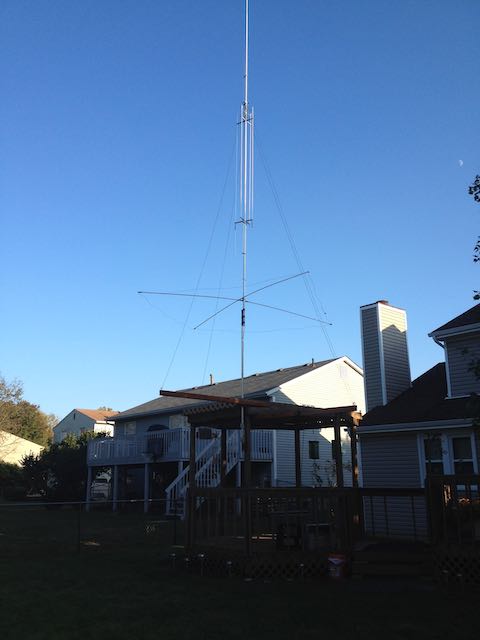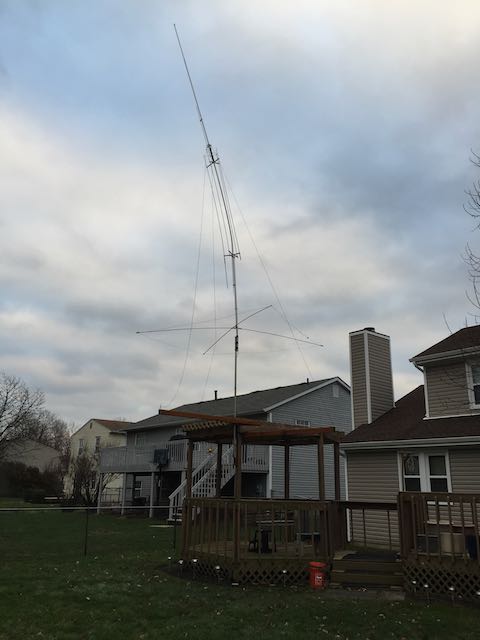My first HF antenna, an off-center fed dipole for 40 meters, lasted about 6 months until September, 2014. At that time, I decided to go to a GAP Titan, a multi-band vertical. Here it is after a day of assembly.

I also ordered an aluminum tilt-over assembly, which is attached to the gazebo behind our house. I found out later that I could get by without using the tilt-over feature but that was OK.
The 40 meter radial hoop was about 25 feet above the ground. As for performance, I expected a low take-off angle which I was hoping for for DX. That is pretty much the way it worked out and I quickly got a lot of the Caribbean area and Europe.
80 meter performance was not so good, as expected for a compromised vertical. But I was generally OK with how it did, especially since I could not get anything longer or higher.
I was concerned about the aluminum tubes supporting the horizontal hoop so I stuck dowel rods in them to stiffen them up. I also bought a guying kit from GAP and used Dacron line to guy the Titan around the gazebo. Later on, I used fishing line to add further support to the ground hoop.
The Titan had not been up for very long before disaster struck.


This was around Thanksgiving, 2014, after a nasty blast of wind roared through. The constant gusting of wind had caused one of the guy lines to loosen up from the vertical part of the Titan and the center part bent over. Clearly shows how important guying is.
I lowered the Titan to ground and managed to mostly straighten the center part and re-raised it. After that, I noticed that SWR on 12 meters was rather poor so I climbed up to add a short length of #14 wire to one of the tuning rods which helped. It might have been when the Titan was down that I added the fishing line.
After another year, I became a full-time CW operator and had a great deal of difficulty tuning the CW part of 80 meters. There is a tuning capacitor at the very top of the Titan that is set at the factory to the higher end of 75 meters. I ordered a different capacitor from GAP and swapped it for the existing one.
That necessitated taking the Titan down again and this time I also further straightened the center mast.
The Titan did work on all bands from 80 meters to 10 meters without a tuner, although 12 meters always had SWR over 2:1. I could even use it on 6 meters and managed to get into some 2 meter repeaters with it.
The Titan always seemed to really rock on 40 meters. It was OK on 80 meters but I seemed to struggle much of the time on 20 meters. Eventually, the sunspot cycle that I enjoyed so much in 2014 and 2015 started to wind down and the higher bands were not as easy to use any longer. It got to the point that 40 meters was about all I used.
One data point was operating in the Ohio QSO Party: in this, picking up Ohio counties as multipliers is pretty important to getting a decent score. I noticed that picking up Ohio counties on 80 meters was not easy; getting out to Wisconsin was. Similarly, on 40 meters, getting to the mid part of the country was easy but picking up more local contacts was a challenge.
Whenever we got a storm roar through or the winds got somewhat violent, which happens a few times a year, I would watch from our kitchen window as the Titan got battered around. I was always so afraid of a repeat of what happened in 2014 where a guy line would loosen up and the already weakened Titan would droop over the neighbor’s fence. I was also concerned about a big ice storm causing damage. Fortunately, those did not happen.
Eventually, I grew frustrated with the lack of ears on 20 meters and thought that, maybe, better performance could be obtained with wires. Another factor was the thinking that we are not going to be at this house much longer and taking the Titan down would be a chore, especially with me getting older and less physically able to mess around with it. This led to a decision that was executed in June, 2020, to retire the Titan and go with a non-resonant doublet.
More on that later.
